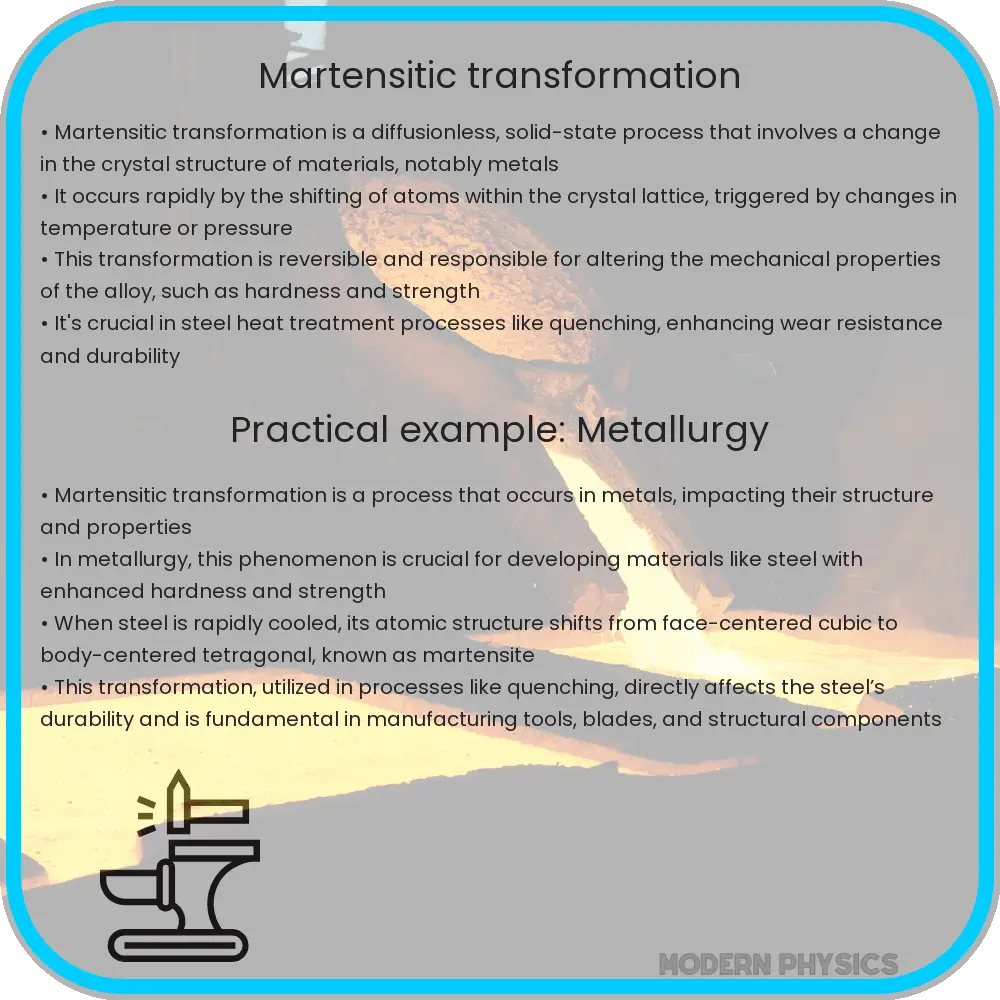A detailed exploration of martensitic transformation, a critical metallurgical process affecting the properties of materials like steel, involving a diffusionless, solid-state change in crystal structure triggered by temperature or stress.

Martensitic Transformation: A Closer Look at a Complex Physical Process
Martensitic transformation is a fundamental, but complex metallurgical phenomenon that plays a crucial role in the properties and applications of many materials, especially steel and other alloys. This transformation involves a change in the crystal structure of a material without diffusion, typically induced by changes in temperature or mechanical stress. Understanding the mechanisms of martensitic transformation, its effects, and applications can provide insights into designing materials with desired mechanical properties.
Mechanisms of Martensitic Transformation
The martensitic transformation occurs primarily in a solid state and is characterized by a rapid transformation kinetics and a diffusionless process. It commences when a parent phase (usually of a high temperature form like austenite in steels) transforms into a martensite phase at a certain temperature or stress level without the atoms diffusing. This transformation is highly dependent on both the external conditions and the intrinsic properties of the material.
At the atomic level, the transformation involves a shear-like motion of atoms that results in a change from one crystal lattice structure to another. This is often from a face-centered cubic (FCC) structure to a body-centered tetragonal (BCT) or body-centered cubic (BCC) structure. The specifics of the crystal change depend heavily on the type of material and its composition.
- Nucleation: This is the initial stage where small regions of the new phase, martensite, start to form. Nucleation often occurs at specific sites such as grain boundaries, defects, or inclusions within the crystal structure.
- Growth: Following nucleation, these martensite nuclei grow rapidly. The growth is governed by the movement of the interface between the parent and product phases, often along specific crystallographic planes.
The actual transformation starts when the material is cooled (or stressed) to the Martensite Start Temperature, Ms, and completes when it reaches Martensite Finish Temperature, Mf. The temperature range within which this transformation occurs is crucial because it determines the extent of the transformation and hence the fraction of martensite formed.
Effects of Martensitic Transformation
The effects of martensitic transformation are predominantly observed in the mechanical properties of the material. Some of the common effects include:
- Increased Hardness and Strength: The transformed martensite phase generally has a much higher hardness and strength than the parent phase due to its distorted lattice structure and the associated strain hardening.
- Change in Shape: Since the transformation involves a change in lattice parameters, it often leads to a macroscopic shape change in the material, known as the shape memory effect, which can be exploited in various applications.
- Increased Brittleness: While increased hardness and strength are advantageous, they often come at the cost of increased brittleness, making the material more susceptible to cracking under stress.
These transformations and their effects are not just of academic interest—they have practical implications in various industrial applications. Martensitic transformation is harnessed in the production of gears, railway tracks, and blades, where high strength and wear resistance are paramount. Moreover, understanding these transformations helps in the alloy design process, allowing engineers to tailor materials for specific needs.
Applications of Martensitic Transformation
Martensitic transformation finds utility in several fields. In the medical sector, the shape memory and superelastic properties of certain alloys, like Nitinol (a nickel-titanium alloy), are utilized in devices such as stents and orthodontic wires. These materials can return to their original shape after deformation, a property critical in medical implants that need to adapt to bodily movements.
In engineering, especially in aerospace and automotive, martensitic steels are favoured for their strength and fatigue resistance. The ability to undergo substantial deformation before failure makes these materials ideal for safety-critical components.
In addition to these, the unique properties of martensitic phases are also explored in cutting tools, bearings, and armor plating, showcasing the broad applicability and importance of this transformation in modern technology and industry.
Challenges in Controlling Martensitic Transformation
Despite its beneficial properties, controlling the martensitic transformation process presents several challenges. Precise control over the transformation temperatures and rates is essential to harness the full potential of the resultant martensitic phase. Variations in manufacturing processes, impurities in materials, and inconsistencies in thermal treatments can lead to undesired properties and performance.
- Reproducibility: Achieving consistent results in different batches of alloys can be challenging, as minor differences in composition or processing conditions can alter the transformation characteristics significantly.
- Sensitivity to Thermal History: The history of thermal treatment plays a critical role in determining the final properties of the material. For instance, unequal cooling rates can lead to non-uniform distribution of martensite, affecting the material’s overall strength and ductility.
- Complex Microstructures: Managing the microstructural changes during martensitic transformation requires sophisticated techniques to observe and quantify the phase evolution and ensure the desired end properties.
Advancements in material science and technologies continue to address these challenges, improving the predictability and utility of martensitic transformations.
Future Prospects
The continuing research and development in the field of martensitic transformations promise to unlock even more applications and improve material properties. Innovations such as 3D printing and nanotechnology hold the potential to create more precise and effective utilization of martensitic transformations, leading to breakthroughs in both existing and emerging fields.
Innovative computational models and experimental techniques are expected to advance our understanding of the phase transformation mechanisms at an atomic level, enhancing our ability to design targeted materials with specific properties.
Conclusion
Martensitic transformation is a fascinating and complex process with significant implications across various industrial sectors. Understanding the mechanisms, effects, challenges, and applications of this transformation permits material scientists and engineers to design and employ materials selectively for optimal performance. As technology progresses, the exploration of martensitic transformation continues to be a pivotal area of research in the pursuit of more resilient, efficient, and adaptable materials.
